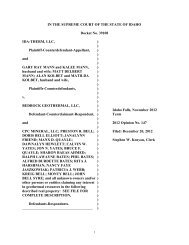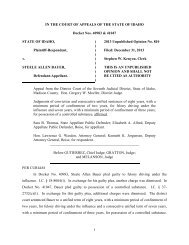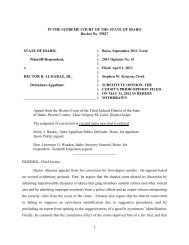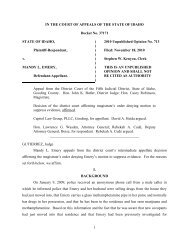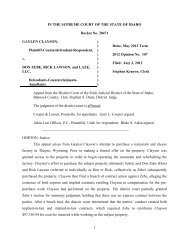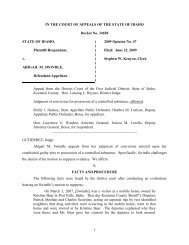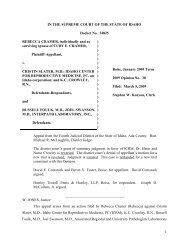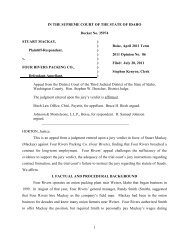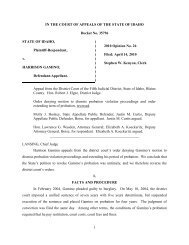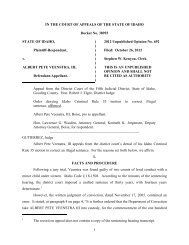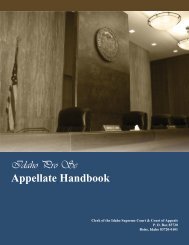State v. William M. Tankovich, Jr. - Idaho State Judiciary
State v. William M. Tankovich, Jr. - Idaho State Judiciary
State v. William M. Tankovich, Jr. - Idaho State Judiciary
Create successful ePaper yourself
Turn your PDF publications into a flip-book with our unique Google optimized e-Paper software.
STATE OF IDAHO,<br />
v.<br />
IN THE COURT OF APPEALS OF THE STATE OF IDAHO<br />
Plaintiff-Respondent,<br />
WILLIAM M. TANKOVICH, JR.,<br />
Defendant-Appellant.<br />
Docket No. 38801<br />
)<br />
)<br />
)<br />
)<br />
)<br />
)<br />
)<br />
)<br />
)<br />
)<br />
1<br />
2012 Unpublished Opinion No. 779<br />
Filed: December 31, 2012<br />
Stephen W. Kenyon, Clerk<br />
THIS IS AN UNPUBLISHED<br />
OPINION AND SHALL NOT<br />
BE CITED AS AUTHORITY<br />
Appeal from the District Court of the First Judicial District, <strong>State</strong> of <strong>Idaho</strong>,<br />
Kootenai County. Hon. John P. Luster, District Judge.<br />
Judgment of conviction for malicious harassment and conspiracy to commit<br />
malicious harassment, affirmed.<br />
Sara B. Thomas, <strong>State</strong> Appellate Public Defender; Justin M. Curtis, Deputy<br />
Appellate Public Defender, Boise, for appellant.<br />
Hon. Lawrence G. Wasden, Attorney General; Jessica M. Lorello, Deputy<br />
Attorney General, Boise, for respondent.<br />
________________________________________________<br />
GRATTON, Chief Judge<br />
<strong>William</strong> M. <strong>Tankovich</strong>, <strong>Jr</strong>. appeals from the judgment of conviction entered upon the jury<br />
verdicts finding him guilty of malicious harassment and conspiracy to commit malicious<br />
harassment.<br />
I.<br />
FACTUAL AND PROCEDURAL BACKGROUND<br />
<strong>Tankovich</strong>, as well as his two brothers, was charged by indictment with one count of<br />
malicious harassment and one count of conspiracy to commit malicious harassment. The<br />
indictment alleged three overt acts. First, Ira <strong>Tankovich</strong> (Ira) made contact with Kenneth<br />
Requena (Requena), who is Puerto Rican, because of his race, color, and/or national origin and<br />
made disparaging racial remarks to Requena. Second, Ira returned to Requena’s home with a<br />
firearm to cause physical injury to Requena and/or threatened physical injury to Requena.<br />
Lastly, <strong>Tankovich</strong> and Frank <strong>Tankovich</strong> (Frank) also returned to Requena’s home and
maliciously made disparaging racial remarks to Requena--with the specific intent to intimidate or<br />
harass--because of his race, color, ancestry, and/or national origin. The <strong>State</strong> moved for a<br />
joinder of <strong>Tankovich</strong>’s case with those of Frank and Ira. The district court ultimately granted the<br />
joinder and the three men were tried together.<br />
Following a mistrial and a hung jury, the <strong>State</strong> sought to introduce evidence at the<br />
subsequent trial regarding <strong>Tankovich</strong>’s tattoos of SS lightning bolts and a three-leaf clover. 1 The<br />
<strong>State</strong> also requested to be allowed to present the testimony of expert Tim Higgins to explain the<br />
significance of <strong>Tankovich</strong>’s tattoos. The district court conducted a hearing outside the presence<br />
of the jury to establish the proper foundation for Higgins’ testimony. During that hearing,<br />
Higgins testified that he “provide[s] administrative oversight for three programs statewide with<br />
the Department of Correction both in probation and parole and in the prison system, one being<br />
the investigations program, the second being the criminal intelligence program, and the third<br />
being the security threat group management program.” Higgins explained that security threat<br />
groups “could mean criminal gang members, it could mean extremist groups, militia groups,<br />
white supremacist organizations, [and] various other groups. . . .” Higgins also explained that<br />
<strong>Tankovich</strong>’s tattoos were Aryan neo-Nazi-type symbols usually associated with white<br />
supremacists or gang members.<br />
Following the hearing on Higgins’ testimony, <strong>Tankovich</strong> expressed his concerns:<br />
[M]y biggest concern is that letting this witness testify, all it’s going to do is<br />
attempt to inflame the jury and say that these people are part of a gang. He has<br />
testified that his only expertise is in identifying if people are part of a gang or a<br />
security threat or whatever nonsense they’re calling it these days, and he has<br />
given you no information that he is at all experienced in just testifying about<br />
relevant sorts of symbols. He has no doctorate, no degree in history. When<br />
discussing these symbols, he says that he hasn’t studied the other uses of them.<br />
And more importantly, your Honor, it seems clear to me that what the<br />
<strong>State</strong>’s hoping to do is have this witness testify and say these people are part of a<br />
gang. That’s the only purpose of his testimony, even if he doesn’t say it.<br />
1 At trial, the <strong>State</strong> also sought to introduce Ira’s tattoos of inverted stars with the words<br />
“Aryan Pride.” No expert testimony was given on those tattoos because the meanings of the<br />
symbols were self-evident.<br />
2
The <strong>State</strong> responded to <strong>Tankovich</strong>’s concerns:<br />
Your Honor, with regards to the potential risk that counsel is referring to, I<br />
think that that’s something that we have begun to address, certainly, in terms of<br />
the nature of the testimony that we’d be presenting to talk about things in terms of<br />
risk groups and rather than gangs and try to address some of the concerns the<br />
Court has.<br />
We wouldn’t be seeking from this witness to testify about these particular<br />
defendants and their beliefs, rather, it’s specialized testimony that this individual<br />
has based on years of experience and training relating to his knowledge of gangs<br />
and risk groups that is a part of his everyday work and has been a part of his<br />
everyday work for his entire career as a corrections officer.<br />
The district court noted “the foundation that Mr. Higgins has laid here in the preliminary<br />
examination could be highly prejudicial in terms of exceeding the boundaries of what it is that<br />
would be relevant” since <strong>Tankovich</strong> is “not on trial for being [a] member[] of a gang.” The<br />
district court also noted that Higgins’ testimony could serve a legitimate purpose as expert<br />
testimony on the symbolism of the tattoos. The district court concluded that the testimony:<br />
[S]hould not be presented to this jury in any way to infer or to imply that [the<br />
<strong>Tankovich</strong>es] had ever been in prison before or that any of these individuals were<br />
necessarily current members of any gangs or any gang affiliation or any of those<br />
things that Mr. Higgins is primarily entrusted to do in his everyday job.<br />
Accordingly, the district court cautioned the <strong>State</strong> to avoid extensive inquiry into Higgins’<br />
background working for the Department of Correction in order to prevent unnecessary inferences<br />
that <strong>Tankovich</strong> was in prison or a member of a specific gang. The district court further clarified<br />
that Higgins could testify about his general job title or his duties. The district court also<br />
suggested that the <strong>State</strong> show Higgins photographs of the tattoos and ask him about his<br />
familiarity and knowledge of them, but that he should not characterize the tattoos as being<br />
associated with gang members.<br />
In front of the jury, Higgins testified that he works at the <strong>Idaho</strong> Department of Correction<br />
as the coordinator of the investigative and intelligence program and that, as part of his duties, he<br />
identifies and categorizes symbols and tattoos in the Department of Correction’s population.<br />
Regarding the symbolism of the lightning bolts tattoo, Higgins testified that he had seen this<br />
symbol approximately 100 times in the past year “on people associated with Aryan neo-Nazi<br />
belief systems or white supremacy belief systems.” Regarding the three-leaf clover tattoo,<br />
Higgins testified that they are “common symbols worn by Aryan white supremacists inside.”<br />
3
The jury ultimately found <strong>Tankovich</strong> guilty of malicious harassment and conspiracy to<br />
commit malicious harassment. The district court sentenced <strong>Tankovich</strong> to a unified five-year<br />
term, with two years determinate, suspended the sentence, and placed him on probation.<br />
<strong>Tankovich</strong> timely appeals.<br />
II.<br />
ANALYSIS<br />
<strong>Tankovich</strong> claims that Higgins’ testimony suggested that he had been to prison or was a<br />
member of a gang which was not relevant. The <strong>State</strong> argues that the testimony was relevant to<br />
the issue of motive. 2 Whether evidence is relevant under <strong>Idaho</strong> Rule of Evidence 401 is an issue<br />
of law which we review de novo. <strong>State</strong> v. Raudebaugh, 124 <strong>Idaho</strong> 758, 764, 864 P.2d 596, 602<br />
(1993); <strong>State</strong> v. Sanchez, 147 <strong>Idaho</strong> 521, 525, 211 P.3d 130, 134 (Ct. App. 2009).<br />
<strong>Tankovich</strong> complains that Higgins’ testimony associating the tattoos with a white<br />
supremacist belief system is the same as associating <strong>Tankovich</strong> with a gang. Further, <strong>Tankovich</strong><br />
asserts that Higgins’ employment with the Department of Correction, together with his<br />
statements that he had seen the lightning bolts tattoo “100 times in the last year” and that the<br />
three-leaf clover tattoo was a common symbol “worn by Aryan white supremacists inside”<br />
(emphasis added), suggested that <strong>Tankovich</strong> had been in prison. This case involves malicious<br />
harassment of a person because of that person’s race, color, ancestry, or national origin.<br />
<strong>Tankovich</strong> disputed that his activities were so motivated. However, <strong>Tankovich</strong> acknowledges<br />
that motive is relevant, stating: “And while Mr. <strong>Tankovich</strong>’s motive to commit was relevant to<br />
the instant charges, his association with a gang was not, nor was the frequency with which Mr.<br />
Higgins saw this tattoo in the prison system.” Higgins was called in response to an early<br />
objection by <strong>Tankovich</strong> that there was a lack of foundation as to what the tattoo evidence meant<br />
and the trial court’s suggestion that an expert might be necessary. Higgins testified that the<br />
tattoos were associated with Aryan white supremacists. <strong>Tankovich</strong> does not deny that Aryan<br />
white supremacist beliefs include racial animus. Higgins’ testimony was specifically tailored to<br />
2 The <strong>State</strong> also contends that <strong>Tankovich</strong> objected to Higgins’ testimony on foundational<br />
grounds and did not preserve his objection to relevance or undue prejudice. Having reviewed the<br />
record, including the various discussions regarding Higgins’ testimony, we conclude that<br />
<strong>Tankovich</strong> preserved both relevance and undue prejudice as grounds for objection to Higgins’<br />
testimony.<br />
4
identify the tattoos with a particular group’s belief system, not a gang, which was never<br />
mentioned. Higgins’ testimony regarding seeing the lightning bolt tattoo 100 times in the last<br />
year came in response to a foundational objection from <strong>Tankovich</strong>. Higgins’ expertise came<br />
from his work inside the prison system. He did not testify or imply that such tattoos were only<br />
associated with imprisoned Aryan white supremacists or that, because he had such tattoos,<br />
<strong>Tankovich</strong> had previously been imprisoned. Higgins’ testimony was relevant to the issue of<br />
motive in this case.<br />
<strong>Tankovich</strong> further argues that even if the Higgins’ testimony was relevant, the testimony<br />
was unfairly prejudicial. Again, <strong>Tankovich</strong> contends that Higgins’ statements concerning his<br />
employment by the Department of Correction, his knowledge of prison tattoos, and association<br />
of the tattoos to a particular group’s belief system led the jury to infer that <strong>Tankovich</strong> had been to<br />
prison or was a member of a gang. Pursuant to I.R.E. 403 evidence, although relevant, may be<br />
excluded if its probative value is substantially outweighed by the danger of unfair prejudice. A<br />
lower court’s determination under I.R.E. 403 will not be disturbed on appeal unless it is shown to<br />
be an abuse of discretion. <strong>State</strong> v. Enno, 119 <strong>Idaho</strong> 392, 406, 807 P.2d 610, 624 (1991); <strong>State</strong> v.<br />
Clark, 115 <strong>Idaho</strong> 1056, 1059, 772 P.2d 263, 266 (Ct. App. 1989).<br />
The district court in this case clearly recognized the potential for prejudice from Higgins’<br />
testimony. The court disallowed certain testimony regarding tattoos, directed the <strong>State</strong> to refrain<br />
from extensive foundation which might prejudice the jury, and precluded references to gangs or<br />
prior imprisonment. Higgins never referred to a gang. Instead, he described each tattoo’s<br />
association to the belief system of a particular group. He did not testify or imply that the group<br />
or its belief system was limited to imprisoned persons. He did not testify or imply that such<br />
tattoos were necessarily obtained in or limited to the prison setting. He did not testify that<br />
<strong>Tankovich</strong> had been incarcerated. Higgins’ frame of reference and source of expertise may have<br />
been from his duties in the correction system, but he did not suggest by that fact that the tattoos<br />
or the group with which they are associated are necessarily prison or gang related. The district<br />
court properly weighed the prospect of unfair prejudice outweighing the probative value of<br />
5
Higgins’ testimony and took steps to minimize any prejudice. The district court did not abuse its<br />
discretion in making the I.R.E. 403 determination. 3<br />
Finally, even if we assume error in the admission of Higgins’ statements, such error was<br />
harmless. Trial error will be deemed harmless if the reviewing court is convinced beyond a<br />
reasonable doubt that the error did not contribute to the verdict. <strong>State</strong> v. Perry, 150 <strong>Idaho</strong> 209,<br />
227, 245 P.3d 961, 979 (2010). In reviewing for harmless error, the court evaluates the potential<br />
prejudice from the inadmissible evidence in the context of the evidence presented at trial. <strong>State</strong><br />
v. Yager, 139 <strong>Idaho</strong> 680, 687, 85 P.3d 656, 663 (2004) (error in failing to suppress evidence was<br />
harmless because probative value of evidence improperly admitted at trial was de minimis in<br />
light of other evidence properly presented to establish defendant’s guilt).<br />
We note, first, that <strong>Tankovich</strong> does not contend that evidence tending to establish racial<br />
animus was not relevant. In other words, he does not directly contend that testimony that<br />
<strong>Tankovich</strong>’s tattoos were associated with Aryan white supremacists and that their views included<br />
racial animosity would be improper. He agrees that evidence of racial motive would be proper.<br />
His complaint here is principally directed at references to the prison setting, that is, Higgins’<br />
testimony that he had learned of the tattoos’ significance from his work in the prison setting, that<br />
there are a number of prisoners with such tattoos, and that the group with which they are<br />
associated has a particular belief system. <strong>Tankovich</strong> asserts that these references lead to the<br />
“inescapable” conclusion that <strong>Tankovich</strong> had been in prison and in a gang. As indicated above,<br />
the prison references were incidental to the main thrust of Higgins’ testimony which directly<br />
related to racial motive.<br />
Testimony at trial established that the Requenas were outside their home. <strong>Tankovich</strong> and his<br />
brothers drove by in a truck, stopped at a nearby stop sign, backed up in front of Requena’s house<br />
and then confronted Requena. On one side of the truck a swastika had been drawn in the dirt on the<br />
truck and the words “Born 2 Kill” had been drawn on the other side. The <strong>Tankovich</strong> brothers acted<br />
aggressively toward Requena and he asked his wife to call 911 and get his gun, which she did. The<br />
3 As noted, Higgins’ testimony regarding having seen the lightning bolt tattoo on 100<br />
occasions in the past year was in response to <strong>Tankovich</strong>’s objection to a lack of foundation. The<br />
district court correctly noted that the “<strong>State</strong> was trying to proceed with a minimal amount of<br />
foundation in response to the concerns that the Court had articulated earlier. If you have a<br />
foundational objection, I suspect it’s probably a legitimate objection, and perhaps some more<br />
foundation can be laid.”<br />
6
<strong>Tankovich</strong> brothers threatened to return and departed before the police arrived and took a statement<br />
from the Requenas and a neighbor. The <strong>Tankovich</strong> brothers returned, twenty to thirty minutes later.<br />
<strong>Tankovich</strong> and his brother Frank approached on foot with a pit bull. They began to threaten<br />
Requena. Ira approached on foot from the other direction with a gun, which he threw in the grass as<br />
police approached, having again been called to the scene. While the police talked with <strong>Tankovich</strong><br />
and Frank, the two men repeatedly called Requena a “fuckin’ beaner” and <strong>Tankovich</strong> threatened that<br />
they would “take care of business” and take care of this “beaner.”<br />
We are convinced from our review of the record that a rational jury would have found<br />
<strong>Tankovich</strong> guilty of the charged crimes even without the alleged improper portions of Higgins’<br />
testimony. We do not believe that the challenged portions of Higgins’ testimony contributed to<br />
the conviction. We therefore conclude that if it was error, it was harmless beyond a reasonable<br />
doubt, Perry, 150 <strong>Idaho</strong> at 227, 245 P.3d at 979, and is not grounds for reversing <strong>Tankovich</strong>’s<br />
judgment of conviction. I.R.E. 103.<br />
III.<br />
CONCLUSION<br />
The testimony concerning <strong>Tankovich</strong>’s tattoos was relevant to a material and disputed<br />
issue concerning the crime charged. Likewise, the testimony was not unfairly prejudicial.<br />
Lastly, even if the district court erred in admitting Higgins’ testimony regarding <strong>Tankovich</strong>’s<br />
tattoos, the evidence was harmless in light of the other admissible evidence showing <strong>Tankovich</strong>’s<br />
guilt. Therefore, <strong>Tankovich</strong>’s judgment of conviction is affirmed.<br />
Judge LANSING and Judge MELANSON CONCUR.<br />
7



